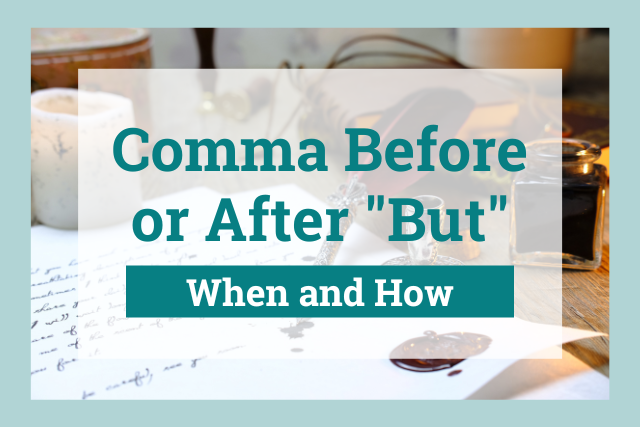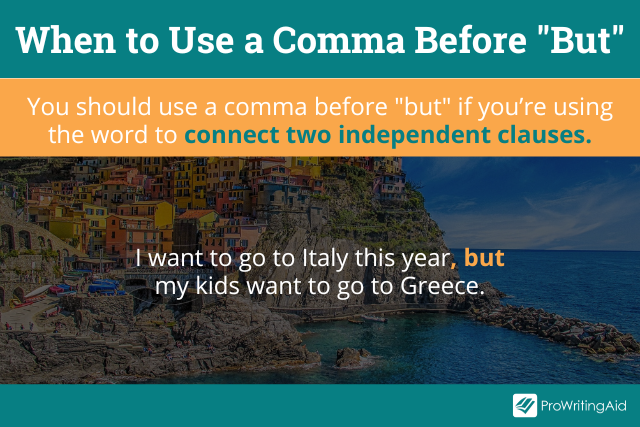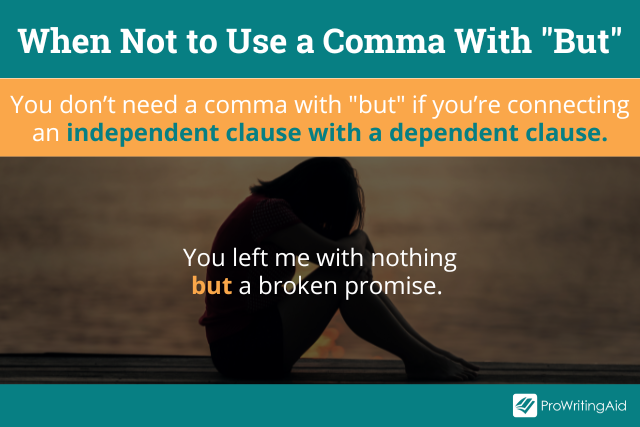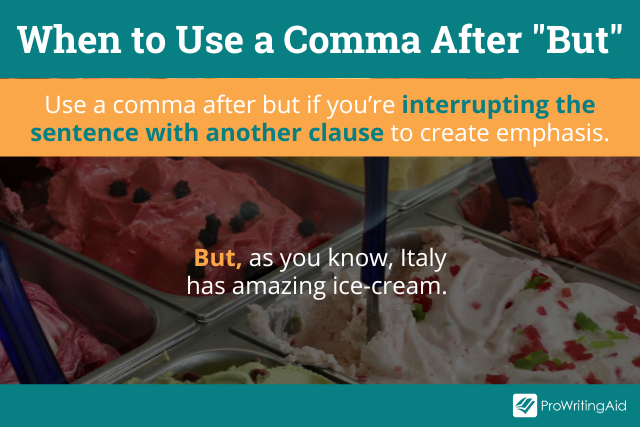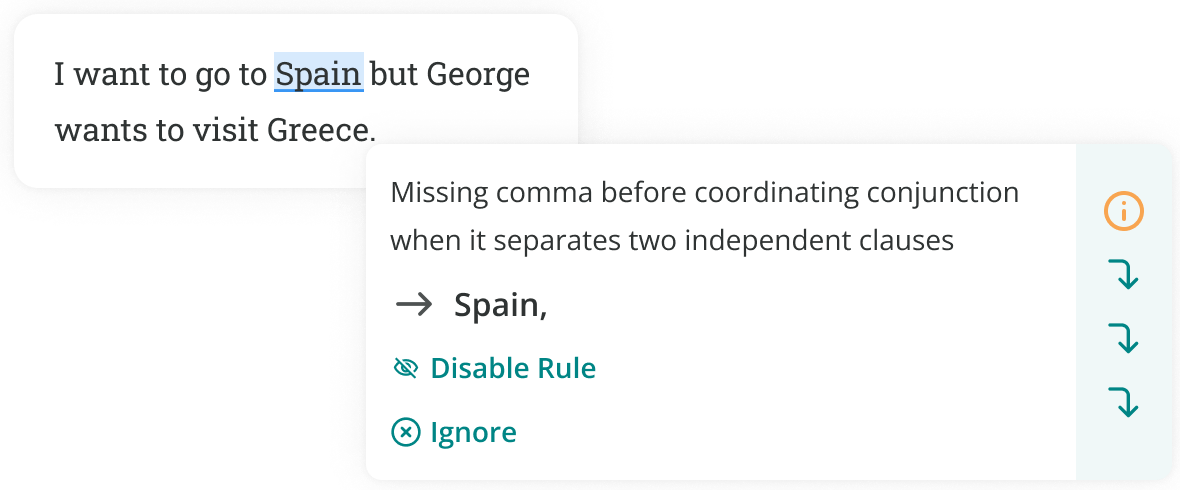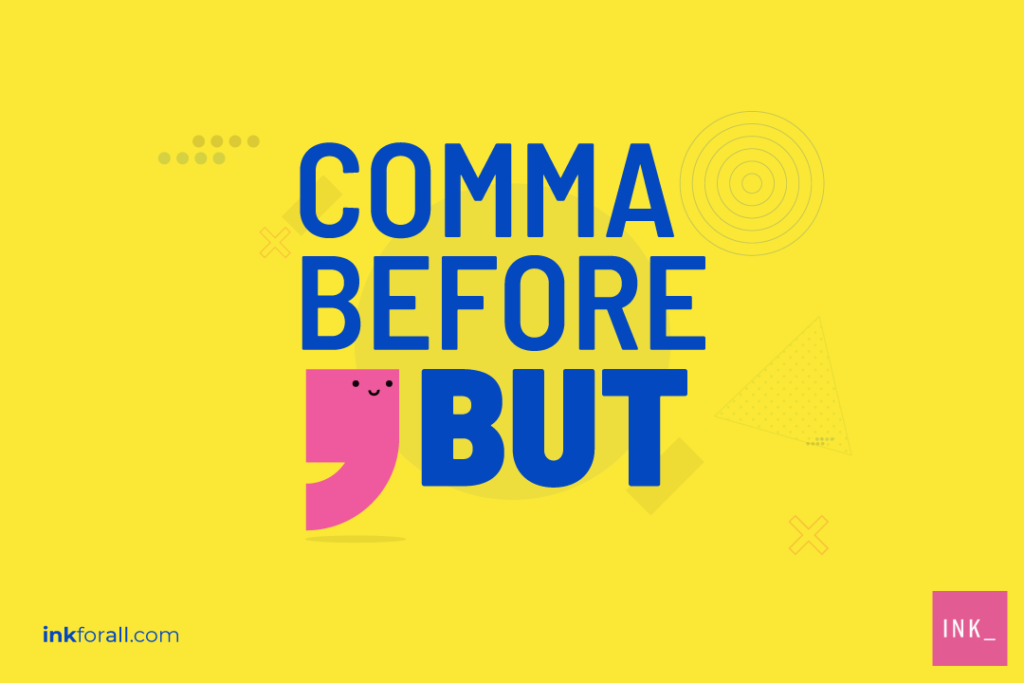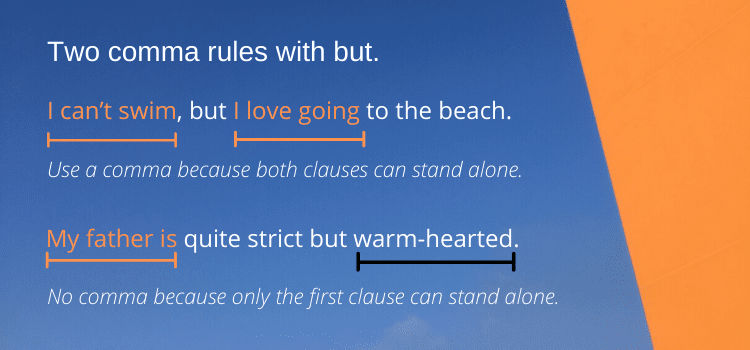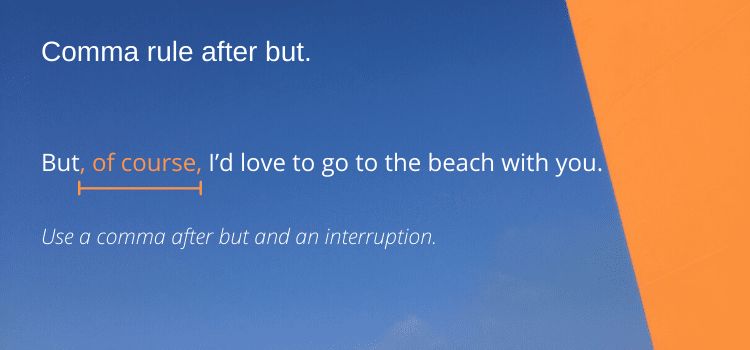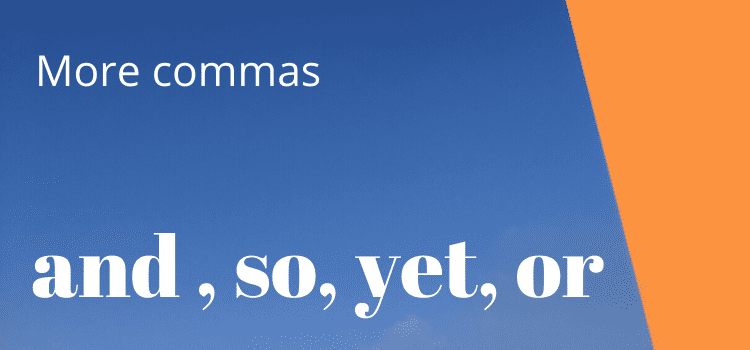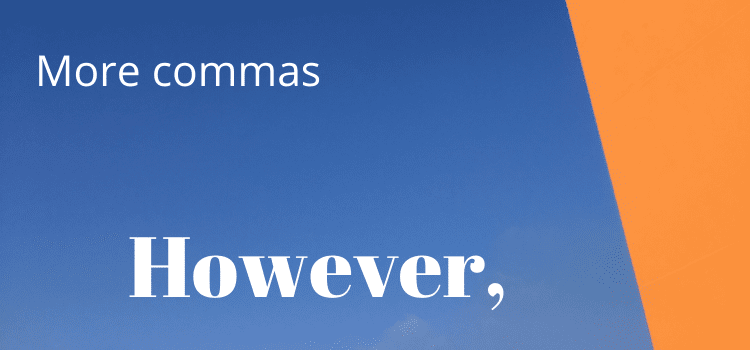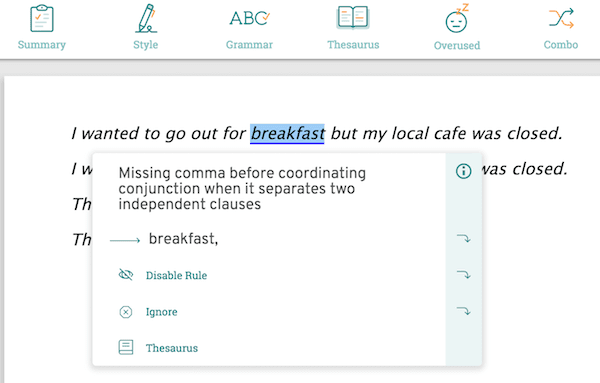If the clause after «but» has a subject and a verb, you need a comma before but. If the clause introduced by «but» does not have a subject in front of the second verb, the comma is often optional.
If the clause after «but» has a subject and a verb, you need a comma before but.
My sister loves cake, but she wants to avoid gaining weight.
My sister loves cake but she wants to avoid gaining weight.
If the clause introduced by «but» does not have a subject in front of the second verb, the comma is often optional. But you can use it to show more contrast or indicate a pause.
I love shopping but don’t have any money.
I love shopping, but don’t have any money.
Contents
- 1. Use a Comma to Introduce an Independent Clause
- 2. The Comma is Optional When Introducing a Dependent Clause
- 3. Other Rules for Placing a Comma Before ‘But’
- 3.1 Use a comma if the clause does not limit or define
- 3.2 Add commas to set off expressions that interrupts the sentence flow
- 3.3 Insert a comma before ‘but’ to separate contrasting parts of a sentence
- 4. More Examples
- 5. Conclusion
- 6. References
1. Use a Comma to Introduce an Independent Clause
As a coordinating conjunction, but joins two clauses of a sentence. If the second clause can stand alone (it has a subject and a verb and forms a complete sentence), add a comma before but.
My brother loves watching TV, but he doesn’t like reading.
My brother loves watching TV but he doesn’t like reading.
Notice that both clauses on either side of the comma can stand alone.
Follow the same rules when using a comma before «and», «or», and other coordinating conjunctions such as «so», «for», «nor», or «yet».
My brother is an artist, and he loves painting.
My brother is an artist and he loves painting.
2. The Comma is Optional When Introducing a Dependent Clause
In some sentences, you don’t need to repeat the subject after but because it is the same in both clauses.
I understand Spanish but cannot speak it.
In the example above, «cannot speak it» is not an independent clause—it cannot stand alone. An independent clause needs a subject and a verb. In this situation, the comma before «but» is optional.
I understand Spanish, but cannot speak it.
Some writers minimize punctuation usage, while others prefer to use more commas to give readers a chance to pause and take a breath.
The classic Blue Book of Grammar and Punctuation argues that using a comma is generally unnecessary when the subject does not appear in front of the second verb.
❝ If the subject does not appear in front of the second verb, a comma is generally unnecessary. Example: Morty thought quickly but still did not answer correctly.❞
Kaufman, Lester; Straus, Jane. The Blue Book of Grammar and Punctuation.
Other authors, however, recommend using a comma if the conjunction is but:
❝ When the subject is the same for both clauses and is expressed only once, a comma is useful if the connective is but. When the connective is and, the comma should be omitted if the relation between the two statements is close or immediate. ❞
Strunk JR., William; White, E.B. The Elements of Style.
As a general rule, you can choose whether to include a comma before but after considering a range of factors, including clarity, emphasis, and rhythm. In any case, add a comma if it makes the sentence clearer.
3. Other Rules for Placing a Comma Before ‘But’
3.1 Use a comma if the clause does not limit or define
Insert a comma before «but» if the second clause does not limit or define; it merely adds something.(1)
For example:
It is not very common, but certainly possible.
By saying «it is not very common», you are already implying that it is possible. Therefore, the phrase «certainly possible» does not limit or define. It just adds information to the main part of the sentence.
3.2 Add commas to set off expressions that interrupts the sentence flow
Use commas to set off expressions that interrupts the flow of a sentence.(1)
I want to go, but not this year, to Italy.
I want to go but not this year to Italy.
3.3 Insert a comma before ‘but’ to separate contrasting parts of a sentence(1)
For example:
The money is in your wallet, but it’s not yours.
4. More Examples
The second clause of these sentences are independent clauses; therefore, we place a comma before but:
- I tried to become a famous singer, but my father ruined it.
- It will be a painful process, but she has no other choice.
- I know it is expensive, but you have a lot of money.
- Yes, I know that you are tired, but you’re not finished.
- It sounds really interesting, but I have decided that I must decline your offer.
- John learns fast, but his attention span is very short.
These are some examples where the comma before but is optional:
- Yes, I have a lot of money, but not for your crazy ideas.
- They are working slowly but surely.
- I bought the car but can’t drive.
- Yes, I know that I am distracted, but cannot take my eyes off that girl when she’s talking.
- The food was good but not delicious.
- I would buy the red one but is too expensive.
5. Conclusion
Follow these guidelines to decide whether to use a comma before but:
- Include a comma before «but» to introduce an independent clause.
- If the subject does not appear in front of the second verb, the comma before «but» is optional.
6. References
(1) Kaufman, Lester; Straus, Jane. The Blue Book of Grammar and Punctuation. Chapter 2 (punctuation).
(2) Strunk JR., William; White, E.B. The Elements of Style.
Download Article
Download Article
When it comes to commas, are you supposed to put one before or after “but”? We know how tricky comma placement can seem, which is why we’re here to help! In this article, we’ll teach you when to use a comma before “but” and when to put one after. With our lessons, tips, and examples, you’ll be placing commas like a pro in no time.
Things You Should Know
- Use a comma before “but” in a compound sentence to separate 2 independent clauses.
- Place a comma after “but” if an interrupting phrase or word (such as «of course» or «in fact») follows it.
- Use a comma before any coordinating conjunction—remember them with the acronym FANBOYS (for, and, nor, but, or, yet, so).
-
1
Place a comma in front of “but” if a sentence has 2 independent clauses. An independent clause expresses a complete thought and can stand alone as a sentence because it includes a subject and verb.[1]
Take a look at your sentence, and underline the phrases before and after the “but.” Can these phrases be read as separate complete sentences? If so, use a comma before the “but.”-
Correct: Jacob saw the movie, but his friend read the book.[2]
- Incorrect: Jacob saw the movie but his friend read the book.
- “Jacob saw the movie” and “his friend read the book” make sense by themselves, meaning they are independent clauses.
- Combining a comma and “but” creates a compound sentence, also known as a sentence with two independent clauses.[3]
-
Correct: Jacob saw the movie, but his friend read the book.[2]
-
2
Don’t use a comma if a sentence has a dependent clause. A dependent clause is an incomplete thought as it lacks a subject and/or verb.[4]
Break your sentence into two parts: the phrase before the “but” and the phrase after the “but.” If both phrases can’t be sentences on their own, then they are dependent clauses and a comma isn’t needed.- Correct: The puppy is small but potty trained.
- Incorrect: The puppy is small, but potty trained.
- Although “The puppy is small” could be a separate sentence, “potty trained” is a dependent clause because it doesn’t have a subject.
Advertisement
-
Use a comma after “but” if an interrupter follows it. An interrupter is a word or phrase that appears in the middle of an independent clause (such as “of course,” “on the other hand,” “in fact,” and “however.”). This word or phrase could be omitted from the sentence but is used for emphasis.[5]
In this case, a comma is used after the “but” and final word in the interrupting phrase to signify that the clause is separate from the rest of the sentence.- Correct: But, of course, I wanted to go to the party with Edith.
- In this example, “of course” is the interrupter, as the sentence can also be read as “But I wanted to go to the party with Edith.”
- Correct: I want to go to Germany, but, on the other hand, I’d miss you terribly.
- In this instance, a comma is before and after “but” because the sentence has 2 independent clauses and “on the other hand” is an interrupter.
- If a sentence doesn’t have an interrupter, don’t put a comma after the “but,” as that would make the sentence grammatically incorrect.
-
A comma is used before “but” because it’s a coordinating conjunction. Coordinating conjunctions are the glue that holds your sentence together. In other words, they’re words that join words, phrases, and clauses into one sentence.[6]
These words can be remembered with the acronym FANBOYS, which stands for for, and, nor, but, or, yet, so. A comma is always placed in front of these words in a compound sentence that has 2 independent clauses.[7]
-
For: She bought an apple, for she wanted a snack.[8]
- And: Nikki lives in Florida, and she goes to Disney World every weekend.
- Nor: Will doesn’t like broccoli, nor does he like eating Brussels sprouts.
- But: The lesson was hard, but we all managed to pass the test.
- Or: We can order pizza, or we can go out to eat.
- Yet: The movie has good reviews, yet my friends and I didn’t like the movie.
- So: I broke my foot over the weekend, so I can’t take the stairs.
-
For: She bought an apple, for she wanted a snack.[8]
Advertisement
Ask a Question
200 characters left
Include your email address to get a message when this question is answered.
Submit
Advertisement
References
About This Article
Thanks to all authors for creating a page that has been read 2,009 times.
Did this article help you?
Get all the best how-tos!
Sign up for wikiHow’s weekly email newsletter
Subscribe
You’re all set!
Should you use a comma before but or after but?
You should use a comma before but whenever you’re connecting two independent clauses. It’s much rarer to use a comma after but.
In this article, we explain this comma rule and give you examples of sentences that use commas before and after but.
Do You Put the Comma Before or After But?
There are three possible situations you might encounter when it comes to using a comma with the word but.
You might need to use a comma before but, you might need to use a comma after but, and you might not need to use a comma at all.
Let’s look at each of these punctuation rules in more detail.
Comma Before But
You should use a comma before but if you’re using the word but to connect two independent clauses.
An independent clause is a string of words that can stand on its own as a complete sentence, with a subject and an object.
For example, “I love food” and “I hate cooking” are both independent clauses.
If you join those two independent clauses with a conjunction, such as “and,” “or,” or “but,” you should use a comma where the period would have been after the first independent clause.
For example, you would use a comma in this sentence: “I love food, but I hate cooking.”
Here are a few more examples of cases when you need to include a comma before but:
- I have a gym membership, but I rarely use it.
- This restaurant has great service, but the food is quite expensive.
- You’re a very nice person, but I only see you as a friend.
Notice that all of the above examples use the word but to connect two independent clauses, both of which could stand alone as complete sentences.
No Comma Before or After But
You don’t need to use a comma before or after but if you’re connecting an independent clause with a dependent clause.
We defined independent clauses earlier. A dependent clause, in contrast, is a string of words that doesn’t form a complete sentence.
For example, the phrase, “only if it’s well-cooked” is a dependent clause. Thus, you wouldn’t use a comma in the following sentence: “I love food but only if it’s well-cooked.”
Here are some other examples of cases when you don’t need a comma:
- Sarah has seven cats but only one dog.
- You had a birthday party but didn’t tell me about it?
- I’m very busy but not because of work.
Notice that in each of the above examples, the clause that follows the word but is dependent, meaning it isn’t a grammatically complete sentence on its own.
Comma After But
Using a comma after but is much rarer than using a comma before but.
You should only do this when you’re interrupting the sentence flow with another word or clause immediately after the word but, to create emphasis.
For example, you might write, “But, my dear, you didn’t tell me the whole story.” In this case, the phrase “my dear” is an interrupter that adds dramatic literary effect.
Here are some other examples of cases when you might include a comma after but:
- “But, as you know, the dodo bird went extinct long ago.”
- “I enjoyed the book, but, to be honest, I didn’t completely understand it.”
- “I tried to go to the grocery store, but, as it turns out, it closed early.”
Notice that all of the above examples include an interrupter immediately after the word but.
Remember that this is a rare situation, so most of the time, you should avoid using a comma after but.
If you’re unsure whether to use a comma before or after but, you can run your writing through ProWritingAid to see if you’re placing all your commas correctly.
When to Use a Comma Before But
The best way to learn grammar rules is by studying examples. Let’s take a closer look at some examples of comma usage from English literature.
Examples of Times to Use a Comma Before But
“Family is a story that is told to you, but the story that matters most you must tell yourself.”—Ken Liu, The Hidden Girl and Other Stories
“She’d always been a great liar. The only difference between lying and acting was whether your audience was in on it, but it was all a performance just the same.”—Brit Bennett, The Vanishing Half
“The rules aren’t written down anywhere, but the important rules rarely are.”—Alix E. Harrow, The Once and Future Witches
Examples of Times to Use No Comma Before or After But
“There was nothing else to do but continue, no matter how frightened she might be.”—Shelley Parker-Chan, She Who Became the Sun
“She was going to elaborate but lost courage when she saw Martha’s expression darken.”—Clare Chambers, Small Pleasures
“They left her in Merilance with nothing but a book.”—V.E. Schwab, Gallant
Examples of Times to Use a Comma After But
“But, of course, Billy felt like it was just people attacking him. When you have everything, someone else getting a little something feels like they’re stealing from you.”—Taylor Jenkins Reid, Daisy Jones & The Six
“I school my face to blankness, but, inside, my emotions are raging like a creek after a spring storm.”—Justina Ireland, Dread Nation
“Nobody’s perfect, she liked to say. But, man, we all fall short so beautifully.”—Richard Powers, Bewilderment
Commas Can Be Complicated, But Here’s One Simple Rule
Now you know when to use a comma before and after but. Remember to use a comma before but only when you’re connecting two independent clauses, and you’ll be good to go!
Take your writing to the next level:
20 Editing Tips from Professional Writers
Whether you are writing a novel, essay, article, or email, good writing is an essential part of communicating your ideas.
This guide contains the 20 most important writing tips and techniques from a wide range of professional writers.

Comma usage can be tricky, and one question that pops up repeatedly is: When to put a comma beforebut? This guide will help you understand how to use commas before and after the conjunction but. We’ll also share a few other tricks of the trade to make using commas easier.
Main Comma Before But Takeaways:
- You need to put a comma beforebut if but connects two independent clauses.
- Independent clauses can stand alone as a sentence. They must express a complete thought.
- A dependent clause doesn’t express a complete thought, so it cannot stand alone as a sentence.
- A comma before but isn’t necessary if both independent clauses are simple and closely related.
- When the but links dependent and independent clauses, no comma is required.
- The only time a comma should follow but is when the but precedes an interrupter.
- An interrupter is a phrase that’s used to create emphasis in a sentence.
The rules of English grammar can be tricky, and comma usage can be the trickiest of all. One recurring comma-related question is when to use a comma beforebut. Thankfully, the guidelines for this particular grammar conundrum are simple.
Do You Use a Comma Before But?
The answer is yes, but only if you are joining two independent clauses. An independent clause can stand by itself as a complete sentence. There are two ways to join two independent clauses in one sentence: using a semicolon or coordinating conjunction like “but.”
If you choose the latter, a comma should always precede “but.” The comma helps show where one independent clause ends, and the other begins. Adding a comma before “but” is a rule applicable to all other coordinating conjunctions, not just “but.” See the example sentences below:
Let’s break that down further.
Defining an Independent Clause
An independent clause is a phrase that can stand alone as a sentence. Although it may represent a single part of a complex sentence, it should express a complete thought. An independent clause must include a verb and a subject.
In this example, “Lisa loved dogs” is an independent clause. It contains a subject and a verb and conveys a complete thought. “She knew the names of every four-legged resident of her neighborhood” is also an independent clause for the same reason.
Exploring Sentences Containing Two Independent Clauses
Sentences may contain two independent clauses as long as they’re punctuated properly. Without correct punctuation, two independent clauses strung together form a run-on sentence.
There are several ways to join two independent clauses in a sentence correctly.
- Separating them with a semicolon.
- Joining them through a conjunction such as or, but, or and.
Examples:
There are several ways to join these two clauses.
This is a comma splice. It’s grammatically incorrect.
In this example, a semicolon effectively connects these two related independent clauses.
This example shows but as a conjunction between these two independent clauses. A comma is required here.
Where to Place the Comma
If you’re connecting independent clauses with a semicolon, you don’t need a comma. If you’re joining two independent clauses with a conjunction, such as but, a comma is required. The comma belongs after the last word in the initial clause, before but (or whichever conjunction you’ve used).
In this example, “commasare important” and “they can be difficult to use” are both independent clauses. They can stand on their own as sentences.
When you Shouldn’t use a Comma Before But
The rule of thumb here is simple: unless but joins two independent clauses, you don’t need a comma. In some sentences, independent clauses are joined to dependent clauses. A comma is not required in these instances.
1. Defining a Dependent Clause
Although a dependent clause contains a subject and verb, it can’t stand alone as a sentence because it doesn’t express a complete thought. These phrases can function as nouns, adjectives, or adverbs.
Word markers often signal dependent clauses. These may include:
- after
- although
- unless
- when
- whether
- since
- as if
- in order to
- whatever
2. Punctuating Sentences That Have Dependent Clauses
If the but in your sentence joins dependent and independent clauses, no comma is necessary.
In this example, “still didn’t get a response” is a dependent clause. It can’t stand alone as a sentence. No comma is needed before the but here.
Other Exceptions
Occasionally, you’ll encounter a joining of two short independent clauses. If the clauses are simple and demonstrate an obvious connection, then no comma is necessary. Although it isn’t grammatically incorrect to use a comma in this instance, it can create a sentence with poor flow. Take for instance the examples below:
The Flip Side: When to Put a Comma After But
The answer: rarely.
A comma should only be used after but when an interrupter follows it. An interrupter is a literary device that’s intended to enhance style. It can be used to evoke emotion, set the tone or pace of a sentence, or emphasize important thoughts or information.
Interrupters may also be called insertions or parenthetical expressions.
In this example, “of course” serves as an interrupter, so a comma is required after the but. This example also includes a comma beforebut since it’s joining two independent clauses.
Commas, Commas, Everywhere: A Brief Conclusion
Grammar rules, including but not limited to commas, can be challenging at best and downright impossible to understand at worst. By exploring individual questions such as when to place a comma beforebut, you’ll learn how to use this grammatical go-to in no time. No buts about it.
Quick Grammar Quiz About Comma Before But
Comma Before But Question #1
Correct!
Wrong!
The answer is TRUE. The comma shows where one clause ends and the other begins.
But Comma Question #2
A. It conveys a complete thought.
B. It can stand alone as a sentence.
C. It must contain a subject and a verb.
D. All of the above.
Correct!
Wrong!
The answer is D. An independent clause contains a subject and a verb, expresses a complete thought, and can stand alone as a sentence.
Comma Before But Question #3
A. Peter wanted to finish the race, he was too tired.
B. Peter wanted to finish the race. He was too tired.
C. Peter wanted to finish the marathon; he was too tired.
D. Peter wanted to finish the marathon, but he was too tired.
Correct!
Wrong!
The answer is A. This sentence is a comma splice.
Comma Question #4
A. A comma is required when connecting independent clauses with a semicolon.
B. A comma is NOT required when connecting independent clauses with a semicolon.
Correct!
Wrong!
The answer is B. You only need a comma when joining two independent clauses with a conjunction.
Comma Before But Question #5
A. A dependent clause can contain a subject and a verb.
B. A dependent clause can stand alone in a sentence.
Correct!
Wrong!
The answer is B. Since dependent clauses don’t convey a complete thought, they can’t stand alone in a sentence.
Comma After But Question #6
A. An interrupter
B. An insertion
C. A parenthetical expression
D. All of the above
Correct!
Wrong!
The answer is D. An interrupter is a literary device that’s intended to enhance style. It’s also known as an insertion or a parenthetical expression.
Read More: When To Use Comma Before Such As: The Definitive Guide
You use a comma before but when you connect two independent clauses. It means each clause has a subject and verb.
There is no comma before but when you join an independent and dependent clause.
In this case, the second clause has no subject or verb.
You only need to use a comma after but when it’s followed by an adverbial clause or interrupter.
The comma with but
Yes, you sometimes need to add a comma when you use but in a sentence.
All you need to do is remember two simple rules.
After you do, it will be easy for you to decide.
All you need to do is look at your complete sentence to know when a comma is needed.
If you follow these two rules, you’ll get the comma right every time.
Two simple but comma rules
There are two basic and simple rules to follow for comma usage.
1. You insert a comma when the two halves of your sentence can stand alone.
2. You omit the comma when the two sentence halves can’t stand alone.
When do you use a comma before but?
To make sure you are correct, check if your sentence joins two independent clauses.
In this case, both clauses will have a subject and a verb. If each part of your sentence is independent, they can stand apart as complete sentences.
Then but, which is your coordinating conjunction, needs a comma to separate your two clauses. Here are some examples of when to use a comma.
I wanted to go out for breakfast but my local café was closed. Incorrect
I wanted to go out for breakfast, but my local café was closed. Correct
This is because each part of the sentence can stand alone as an individual complete sentence.
Each one has a subject and a verb, so you are connecting two independent clauses.
I wanted to go out for breakfast. Complete My local café was closed. Complete
More examples of correct usage:
He left home early, but he forgot to take an umbrella. Correct
My sister is leaving for Canada tomorrow, but she will return in three weeks. Correct
Susan doesn’t like sardines, but her sister loves all kinds of fish. Correct
We wanted to go to Spain for our holiday, but the hotels are too expensive in summer. Correct
I meant to buy some bread, but I forgot to stop at the bakery. Correct
When do you omit the comma?
If the second part of a sentence is a dependent clause, there is no comma.
This happens when you cannot make a logical sentence from the second clause because it depends on the first clause for its meaning.
It is because there is no subject with a verb in the second clause.
Look at these examples.
The restaurant was fantastic, but very expensive. Incorrect
The restaurant was fantastic but very expensive. Correct
You can see that the second phrase is not a complete sentence.
The restaurant was fantastic. Complete Very expensive. Incomplete
More examples:
Studying grammar is hard sometimes but interesting all the same. Correct
I went to the concert but left early with a headache. Correct
The rest of the sentence was easy to write but with poor spelling. Correct
Going to the gym is tough some mornings but good fun all the same. Correct
He played as well as he could but lost the match. Correct
The example sentences above show that there is no subject with a connecting verb in the second clause.
Be careful, though, because there can be a verb. If the verb doesn’t have a subject, it is not an independent clause.
You can see this is the last example sentence above with the verb lost.
When do you use a comma after but?
If you start a sentence with but, you don’t need to use a comma.
You might want to refresh your memory about starting a sentence with but.
You only add one when there is an adverbial clause or an extra word or phrase following it.
Think of it at the beginning of a sentence as marking an interruption to a sentence.
For example:
But, yes, indeed, there is plenty of space in the car for you.
But, on the other hand, I might go to Spain instead.
I was going to buy tickets for the new show, but, in fact, my husband had already bought them for me.
But, if you really want to know the truth, I can’t stand my boss.
College isn’t easy, but, well, you know how it is.
The good news about the but comma rule
Does the comma go before or after but? Now you know the answer.
You have mastered the rule. I told you it was super easy.
Here’s a quick summary of the rule.
When do you use a comma before but?
Use a comma before but when the two sentence halves can stand alone.
When do you omit the comma before but?
Don’t use a comma before but when the second clause can’t stand alone.
When do you need a comma after but?
Use a comma after but only when it is followed by an interruption.
I have more good news for you.
You can use the same three-part rule for a sentence with and, or, yet, and so.
Examples before and, so, yet, and or
He went to London for two weeks, and he stayed at an expensive hotel.
Susan loves her cat, and she lets it sleep in her bed.
Mary loves her dog, yet she doesn’t let it onto her bed.
There was no chance of changing our flight, so we had to stay for two more days.
Tim missed his train, so he was two hours late for the meeting.
You can try for a free upgrade, or you can pay extra to be sure you get it.
My advice is don’t pack too much, or you will be charged for excess baggage.
Examples after and, so, yet, and or
He went to London for two weeks, and, just like him, he stayed at an expensive hotel.
Susan loves her cat, and, naturally, she lets it sleep in her bed.
Mary loves her dog, yet, like many dog owners, she doesn’t let it onto her bed.
There was no chance of changing our flight, so, unfortunately, we had to stay for two more days.
A comma after and before however
Because you can use however as a synonym for but, it is worth noting this extra related rule.
Does the comma go before or after however? It can be before, or before and after.
If you use however, therefore, furthermore, or moreover at the beginning of a sentence, there is always a comma after the adverb.
However, she expects to finish her novel by summer.
Furthermore, we will buy twenty copies of your new book.
Therefore, we will be an active promoter of your new novel.
Moreover, we would like to write a review for our newspaper.
When you are joining two independent clauses, however, take care.
You could wrap the word however in two commas. But for conjunctive adverbs, it is always better to use a semicolon.
I plan to finish my book by summer; however, it could be a little later.
I received your suggested edits; therefore, I’ll take your advice and start on my second draft.
The edits were incomplete; moreover, it seems that the proofreading was poor.
You missed so many errors; therefore, I think I will need to find a new editor.
If you use these adverbs for emphasis, it is quite easy. Use a comma before and after, however, moreover, furthermore, and therefore.
You can, however, proceed with the corrections.
It was, moreover, a very poor effort.
It is, furthermore, out of my control.
You may, therefore, continue with the project.
Summary
It is easy to learn the punctuation rules for coordinating conjunctions.
You can also use a reliable grammar checker to help you check and correct your comma usage.
Just take a few minutes to make sure you understand the basic rules, and then lock them away in your memory.
If there is a subject with a verb in the second clause, use a comma. If there is no subject with a connecting verb, omit it.
Yes, there are some complicated rules that can cause confusion. The ones for cumulative and coordinate adjectives or a comma splice can be a bit tricky.
It is true that punctuation can be complex and often open to interpretation. It is especially so for the Oxford Comma.
Luckily, the rules in this article are easy. So you can leave all the other comma rules for another day.
I’m always reminded of this quote when I think about punctuation.
“I spent all morning putting in a comma and all afternoon taking it out.” – Oscar Wilde.
Related reading: Use A Comma Before And In A List





